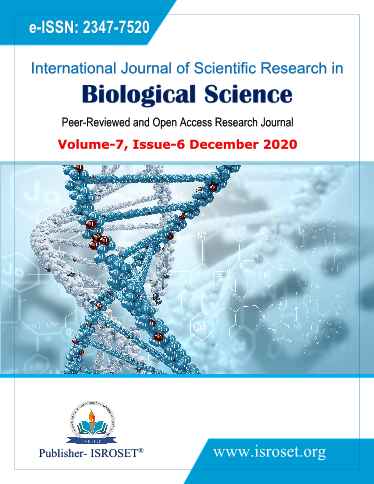Investigation of Carmofur-Derived Growth Supression in Lung Cancer Cell
Keywords:
Carmofur, Lung cancer, Apoptosis, Cancer treatment, CytotoxicityAbstract
Lung cancer is a malignant form of uncontrolled cell growth in lung tissues with high incidence of mortality in the world. Despite the rise in survival ratios in recent five years lung cancer patients survived relatively poor because of the treatment limitations. Chemotherapeutics have biggest handicap in their usage for cancer treatment that cancer cells develop resistance to them. Herein, carmofur, a form of pyrimidine analogue was used for stimulating cell death in lung cancer cells based on its anti-proliferative potency in many cancer cells. Cytotoxic activity was tested via MTT assay. In addition, ultrastructural and morphological changes were evaluated via transmission and confocal microscopies. The IC50 value was determined to be 23 µM for 24 hours. Morphological and ultrastructural analyses imply to clear apoptosis. Consecutively, carmofur might be suggested for deeper examinations in the manner of improvement of the apoptosis triggering potency for designing a florouracil-derived permanent antineoplastic agent.
References
M.A. Phanse, P.D. Chaudhari, S. Birambole, S.R. Pattan, M.J. Patil, R.S. Dhikale, ‘’Cytotoxic Assays for Lung and Colon Cancer,’’ Pharmacologyonline, Vol. 1, pp.979-995, 2010.
H. Furuya, Y. Shimizu, T. Kawamori, ‘’Sphingolipids in cancer,’’ Cancer Metastasis Reviews, Vol. 30, pp.567, 2011.
L. Riboni, R. Campanella, R. Bassi, R. Villani, S.M. Gaini, F. Martinelli-Boneschi, P. Viani, G. Tettamanti, ‘’Ceramide Levels are Inversely Associated with Malignant Progression of Human Glial Tumors,’’ Glia, Vol. 39, Issue.2, pp.105-13, 2002.
B. Ogretmen, Y.A. Hannun, ‘’Biologically Active Sphingolipids in Cancer Pathogenesis and Treatment,’’ Nature Reviews Cancer, Vol. 4, Issue.8, pp.604-616, 2004.
R. Kolesnick, ‘’The Therapeutic Potential of Modulating the Ceramide/Sphingomyelin Pathway,’’ Journal of Clinical Investigation, Vol. 110, Issue.1, pp.3-8, 2002.
D. Canals, D.M. Perry, R.W. Jenkins, Y.A. Hannun, ‘’Drug Targeting of Sphingolipid Metabolism: Sphingomyelinases and Ceramidase,’’ British Journal of Pharmacology, Vol. 163, Issue.4, pp.694-712, 2011.
X. Liu, J.C. Cheng, L.S. Turner, S. Elojeimy, T.H. Beckham, A. Bielawska, T.E. Keane, Y.A. Hannun, J.S. Norris, ‘’Acid Ceramidase Upregulation in Prostate Cancer: Role in Tumor Development and Implications for Therapy,’’ Expert Opinion on Therapeutic Targets, Vol. 13, Issue.12, pp.1449–1458, 2011.
A.E.M. Mahdy, J.C. Cheng, L. Jun, ‘’Acid Ceramidase Upregulation in Prostate Cancer Cells Confers Resistance to Radiation: Ac Inhibition, A Potential Radiosensitizier,’’ Molecular Therapy, Vol. 17, Issue.3, pp.430–438, 2009.
P. Zhang, S. Liu, ‘’Solvent Effects on the UV Absorption Spectrum of Carmofur,’’ Scientific Research Publishing Inc, Vol. 4, pp.25-31, 2016.
N. Realini, C. Solorzano, C. Pagliuca, D. Pizzirani, A. Armirotti, R. Luciani, M.P. Costi, T. Bandiera, D. Piomelli, ‘’Discovery of Highly Potent Acid Ceramidase Inhibitors With in Vitro Tumor Chemosensitizing Activity,’’ Scientific Reports, Vol.3, pp.1035, 2012.
E.M. Saied, C. Arenz, ‘’Small Molecule Inhibitors of Ceramidases,’’ Cellular Physiology and Biochemistry, Vol. 34, Issue.1, pp.197-212, 2014.
I. Domracheva, R. Muhamadejev, M. Petrova, E. Liepinsh, A. Gulbe, I. Shestakova, G. Duburs, P. Arsenyan, ‘’1,2-Dimyristoyl-sn-glycero-3-phosphocholine (DMPC) Increases Carmofur Stability and In Vitro Antiproliferative Effect,’’ Toxicology Reports, Vol. 2, pp.377–383, 2015.
M. Furukawa, T. Karakama, M. Kaji, S. Gomita, M. Yoshimura, N. Watanabe, ‘’Collaborative Work to Evaluate Toxicity on Male Reproductive Organs by Repeated Dose Stud?es in Rats 16) Effects Of Short-Term Administration of Carmofur on Spermatogenesis,’’ The Joumal Of Toxicological Sciences, Vol. 25, pp.163-171, 2000.
O.A. Greer, N. Amoyal, L. Nisotel, J.N. Fishbein, J. Macdonald, J. Stagl, I. Lennes, J.S. Temel, S.A. Safren, W.F. Pirl, ‘’A Systematic Review of Adherence to Oral Antineoplastic Therapies,’’ The Oncologist, Vol. 21, Issue.3, pp.354-76, 2016.
M.A. Feitelson, A. Arzumanyan, R.J. Kulathinal, S.W. Blain, R.F. Holcombe, J. Mahajna, M. Marino, M.L. Martinez-Chantar, R. Nawroth, I. Sanchez-Garcia, D. Sharma, N.K. Saxena, N. Singh, P.J. Vlachostergios, S. Guo, K. Honoki, H. Fujii, A.G. Georgakilas, A. Bilsland, A. Amedei, E. Niccolai, A. Amin, S.S. Ashraf, C.S. Boosani, G. Guha, M.R. Ciriolo, K. Aquilano; S. Chen, S.I. Mohammed, A.S. Azmi, D. Bhakta, D. Halicka, W.N. Keith, S. Nowsheen, ‘’Sustained Proliferation in Cancer: Mechanisms and Novel Therapeutic Targets,’’ Seminars in Cancer Biology, Vol. 35 Suppl, 25-54, 2015.
G. Ku?, ‘’Cytotoxic and Apoptotic Function of Carmofur in Hepatocellular Carcinoma,’’ Kocatepe Medical Journal, Vol. 18, pp.55-60, 2017.
E. Çömlekçi, C. Vejselova Sezer, H.M. Kutlu, ‘’Handling a Novel Nanoscale D-Erythro-Mapp in Lung Cancer Treatment: an in Vitro Cytotoxicity Research,’’ International Journal of Scientific Research in Biological Sciences, Vol.7, Issue.4, pp.14-18, 2020.
Downloads
Published
How to Cite
Issue
Section
License

This work is licensed under a Creative Commons Attribution 4.0 International License.
Authors contributing to this journal agree to publish their articles under the Creative Commons Attribution 4.0 International License, allowing third parties to share their work (copy, distribute, transmit) and to adapt it, under the condition that the authors are given credit and that in the event of reuse or distribution, the terms of this license are made clear.







